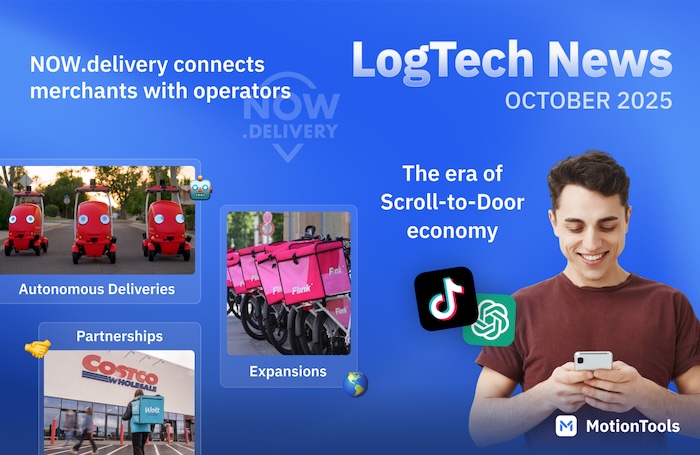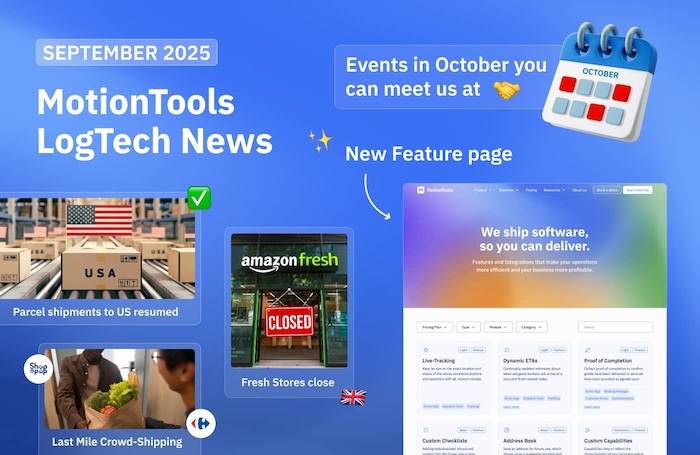Last-Mile Delivery is a key element to cater to consumers' transformed online shopping habits in recent years
How we shop and order everyday items has significantly changed in the last two years. The pandemic has enabled e-commerce businesses to grow like a wildfire. Also, the highly popular grocery delivery services of Flink, Gorillas, and Getir have introduced a new standard of convenience for consumers.
As a delivery software provider, we observe that the new normal of home delivery has accelerated the rise of next-generation commerce services that span every category from fashion and pharmacy delivery to instantly shipping construction materials or dispatching service workers.
Despite their concepts, many of these businesses have to solve the same question: How to win at Last-Mile Delivery and achieve long-term profitability.
In this blog post, we will address the opportunity of last-mile delivery, and the challenges, and introduce our best practices on how to win and get ahead in the game.
Last-Mile Delivery: Definition
Last-mile delivery describes the transportation of goods from a warehouse, dark store, or distribution hub to the final delivery destination - the door of the customer.
However, it can also work vice versa: the simple pickup of goods by a courier at a customer. Last-mile logistics have become a central differentiator for companies with room to grow: The global last-mile delivery market size is projected to grow by 67% from 2020 to 2026.

The Key Challenges of Last-Mile Delivery
The pandemic has been an accelerator for online shopping and delivery. Consumers have gotten used to convenience. Companies cannot lose in the last-mile delivery game since the pandemic behavior appears to be here to stay: According to the EY Future Consumer Index, 60% of US shoppers visit brick-and-mortar stores less than before the pandemic, and 43% shop more often online for products they would have previously bought in stores.

The goal is also the challenge of last-mile operations: Delivering the goods as fast, affordable, and accurate as possible. In everyday operations, this means solving the challenge of ensuring transparency and tracking, improving the overall infrastructure, and increasing the cost-efficiency of the delivery to become long-term profitable. Besides great delivery drivers, this can only be solved with the right technology.
How to succeed at Last-Mile Delivery
The rewards are high for a positive delivery experience: 74% of consumers say they increase their spending by 12% with the retailer when they are satisfied with the delivery service. While 48% intend to stop purchasing from the poor-performing retailer. Those who continue to shop at the poor-performing retailer plan to reduce their spending by 45%.
Here are our top best practices from our experience as a delivery software provider of processing over 10 million deliveries to what distinguishes successful ventures:
Identify the right software for your market
Many companies enter the market without a real understanding of their target market’s needs and challenges - hence, which problems to solve for their customers with delivery. Successful last-mile delivery is not about one-fits-all approaches anymore but about creating tailor-made solutions and services that cater to the specific urban environments.
If you, for example, operate in the hyper-local grocery delivery space, you want to make sure that your orders are dispatched not only to the right driver but to the right warehouse or dark store in the closest proximity to the customer in the first place for fast delivery. Usual platforms don’t have that capability.
For alcohol beverage delivery, you will require software that enables your drivers to verify the IDs of the customers at the delivery location. Furthermore, introducing a deposit collection for the empty bottles and giving the customer credit for it can be a true game-changer - if your software allows it.
At the same time make sure that the software gets the basics right: Choose a delivery management software that is built API-first, works with Webhooks to create new orders from ERPs, and lets you share the driver's live location and delivery status in a customer-friendly way.
Besides choosing the right delivery software to manage your operations you will consider further tools that help you build a great stack for all aspects of your delivery business. Learn more about 26 essential SaaS tools for every delivery venture.
Don’t waste time by building things from scratch
Last-mile delivery is highly competitive and demands fast executions. Building your own system is costly, time-intensive, and in many cases not rewarding: Choosing a SaaS partner enables you to focus on your strategy and less worrying about building features that already exist and that can be easily adopted.
On top of a quick go-live, you will also save resources by choosing a technology partner that offers you a white-label solution. Your branded dashboard, driver app to be hosted in your app store including your own logo, corporate identity colors, and custom domain will give you an advantage in time to market and true service differentiation.
Pick a partner where you receive the support that you need: If customer support at your provider is not included or the support team is not adequately trained to help swiftly in this time-critical business, you are working with the wrong supplier.
How to make Last-Mile profitable?
After all, the main challenge is to improve margins in the competitive last-mile sector. The industry is being watched more closely on its quest for profitability with leading operators like Gorillas needing to downsize in order to achieve their ambitious goals.
While working out the basics and specific must-haves for your operations there is one performance indicator that is crucial in any market: Cost per delivery.
No matter what type of last-mile delivery you are launching keep your focus on cost per delivery to build your path to profitability. For example, batching your orders and thereby reducing the number of drivers. If you combine your stacking strategy with route optimization and introduce driver analytics you can achieve a tremendous effect on your costs.
How can we help your business succeed?
Are you launching a quick commerce business or upgrading your delivery operations?
After more than 10million orders through our customers, MotionTools has an in-depth understanding of what features helped businesses succeed in today’s fast-changing market.
Sign up for a free trial or speak to our team of product experts for a MotionTools demo that helps you configure our software to the requirements of your service.
Our technology platform MotionTools is utilized by startups, corporates, and SMBs all over the world to streamline the dispatching of delivery jobs at scale.












